Contents
What is a Video Annotation Tool?
Top 8 Video Annotation Tools for Computer Vision
Best Paid Video Annotation Tools
Best Free Video Annotation Tools
How To Pick the Best Video Annotation Tool for Computer Vision Projects?
Best Video Annotation Tools: Key Takeaways
Encord Blog
Top 8 Video Annotation Tools for Computer Vision [Updated 2025]
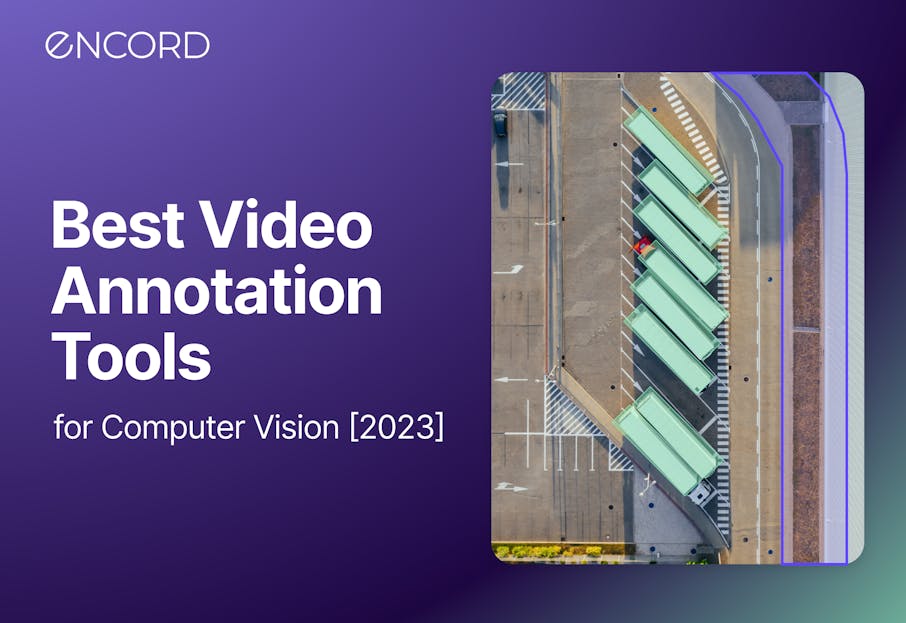
Are you looking for a video annotation tool for your computer vision project? We've compiled a list of the top eight best video annotation tools, complete with their use cases, benefits, key features, and pricing.
The right tool can make all the difference, especially if you’re dealing with large datasets or finding manual annotation too slow and costly. A powerful video annotation platform allows you to streamline your workflow, reduce costs, and focus on extracting meaningful insights from your data.
This guide is tailored for:
- Data ops teams managing in-house or outsourced annotators.
- CTOs aiming to cut down the time and expense of manual annotation.
- Data scientists and ML engineers looking for ways to automate labeling and handle edge cases and outliers with greater efficiency.
Ready to transform your annotation process? Let’s dive into the details!
What is a Video Annotation Tool?
A video annotation tool is used to label video data for the purpose of training machine learning and computer vision models. It is a key part of the data development process as it helps accurately label each frame in a video, ensuring the success of the deployed model. This type of platform is designed to label or tag not only objects but also actions, events, or other elements in video footage.
Let’s take the example of developing a model for an autonomous vehicle. The model needs to understand the different visual elements on the road, such as traffic lights, the surrounding cars, and other obstacles in the road. However, in order for this to happen, the model must be trained on video data in which each of these elements is clearly labeled. A video annotation tool would be used for object detection (ex: vehicles, pedestrians), semantic segmentation (ex: roads, lanes) and object tracking for moving elements (ex: cyclists). In the case of the autonomous vehicle, a video annotation tool is crucial for not only training the model but also for the safety of those driving and others on the road.
However, autonomous vehicles are only one use case for a video annotation tool. The applications can range from surveillance and security to healthcare and retail.
Top 8 Video Annotation Tools for Computer Vision
Most popular paid data annotation tools:
- Encord
- SuperAnnotate
- Dataloop
- Supervisely
- Scale
Most popular free video annotation tools:
- LabelMe
- CVAT
- Img Lab
Here is an overview of the tools we will be covering:
| Tool | Description | Key Features | Best For |
| Encord | Collaborative video annotation platform for faster data labeling and model development. | AI-powered object tracking, quality assessment, multi-modal video support, collaborative dashboards. | ML and data ops teams seeking efficient, collaborative, end-to-end video annotation. |
| LabelMe | Open-source tool developed by MIT, ideal for academic projects. | Includes 3D datasets, supports annotations via MATLAB toolbox, integrates with Amazon Mechanical Turk. | ML and annotation teams, especially in academia or research projects. |
| CVAT | Open-source tool originally by Intel, now under the OpenCV ecosystem. | Supports classifications, segmentations, 3D cuboids, skeletons, with a large community for support. | Data ops teams needing a robust, community-supported annotation tool. |
| SuperAnnotate | Commercial platform for annotation, data management, and workflows. | Data Studio, AI-powered workflows, supports diverse industries like healthcare, insurance, and autonomous driving. | ML engineers, data scientists, and enterprise teams managing AI pipelines. |
| Dataloop | Data engine for AI" with AI-powered annotation and dataset management. | Supports video formats, automated labeling, end-to-end QA and workflow management. | Enterprise AI teams managing video annotation workflows and collaborative projects. |
| Supervisely | Enterprise-grade platform with unified OS for computer vision. | Native video file support, multi-track timelines, automated object tracking, collaborative QA tools. | Fortune 500 companies and advanced computer vision research teams. |
| Scale | Data labeling and project management platform tailored for generative AI and enterprise needs. | Synthetic data generation, full-stack generative AI platform, LLM applications, and enterprise-grade solutions. | Generative AI companies, US government agencies, enterprise organizations. |
| Img Lab | Lightweight, open-source image annotation tool. | Simple to use but requires integration with other tools for large projects. | Annotators and those needing a quick, free tool for small-scale projects. |
Best Paid Video Annotation Tools
Encord
Encord's collaborative video annotation platform helps you label video training data more quickly, build active learning pipelines, create better-quality datasets and accelerate the development of your computer vision models.
Encord's suite of features and toolkits includes an automated video annotation platform that will help you 6x the speed and efficiency of model development.
Encord is a powerful solution for teams that:
- Need a native-enabled video annotation platform with features that make it easy to automate the end-to-end management of data labeling, QA workflows, and automated AI-powered annotation
- Want to accelerate their computer vision model development, making video annotation 6x faster than manual labeling.

Benefits & key features:
- Encord is a state-of-the-art AI-assisted labeling and workflow tooling platform powered by micro-models, ideal for video annotation, labeling, QA workflows, and training computer vision models
- Built for computer vision, with native support for numerous annotation types, such as bounding box, polygon, polyline, instance segmentation, keypoints, classification, and much more
- As a computer vision toolkit, it supports a wide-range of native and visual modalities for video annotation and labeling, including native video file format support (e.g., full-length videos, and numerous file formats, including MP4 and WebM)
- Automated, AI-powered object tracking means your annotation teams can annotate videos 6x faster than manual processes
- Assess and rank the quality of your video-based datasets and labels against pre-defined or custom metrics, including brightness, annotation duplicates, occlusions in video or image sequences, frame object density, and numerous others
- Evaluate training datasets more effectively using a trained model and imported model predictions with acquisition functions such as entropy, least confidence, margin, and variance with pre-built implementations
- Manage annotators collaboratively and at scale with customizable annotator and data management dashboards
Best for:
- ML, data ops, and annotation teams looking for a video annotation tool that will accelerate model development.
- Data science and operations teams that need a solution for collaborative end-to-end management of outsourced video annotation work.
Modalities covered:
- Image
- Video
- DICOM
- SAR
- Documents
- Audio
Pricing:
Start with a free trial or contact sales for enterprise plans.
Further reading:
- The Complete Guide to Image Annotation for Computer Vision
- 4 Ways to Debug Computer Vision Models [Step By Step Explainer]
- Closing the AI Production Gap with Encord Active
- Active Learning in Machine Learning: A Comprehensive Guide
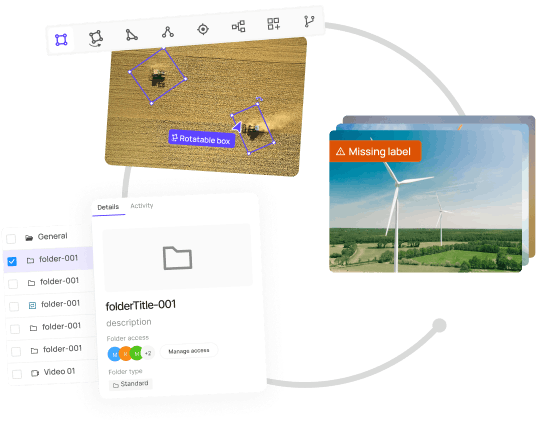
SuperAnnotate
SuperAnnotate is a commercial platform and toolkit for creating annotations and labels, managing automated annotation workflows, and even generating images and datasets for computer vision projects.

SuperAnnotate
Benefits & key features:
- SuperAnnotate includes a full-service Data Studio, including access to a marketplace of 400+ outsourced annotation teams and service providers
- It also comes with an ML Studio to manage computer vision and AI-based workflows, including AI data management and curation, MLOps and automation, and quality assurance (QA)
- It’s designed for numerous use cases, including healthcare, insurance, sports, autonomous driving, and several others.
Best for:
ML engineers, data scientists, annotation teams, and MLOps professionals in academia, businesses, and enterprise organizations.
Modalities Covered:
- Image
- Text
- Video
- Audio
Pros:
- Supports a wide range of annotation types
- Includes AI-assisted labeling features
- Integrates with popular machine learning frameworks
Cons:
- Doesn’t provide built-in annotators
- Not as specialized for natural language processing (NLP) tasks as other platforms
- Challenges with large video datasets or high-resolution media
Pricing:
Free for early-stage startups and academic researchers. You would need a demo or contact sales for the Pro and Enterprise plans.
Dataloop
Dataloop is a "data engine for AI" that includes automated annotation for video datasets, full lifecycle dataset management, and AI-powered model training tools.
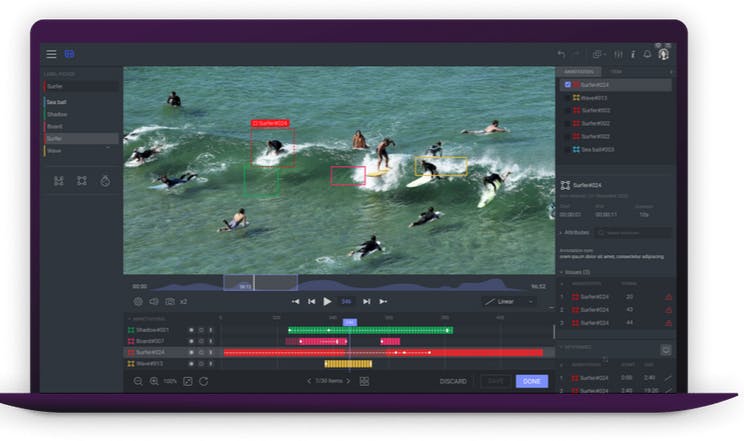
Dataloop
Benefits & key features:
- Multiple data types supported, including numerous video file formats
- Automated and AI-powered data labeling
- End-to-end annotation and QA workflow managment and dashboards for collaborative working
Best for:
ML, data ops, enterprise AI teams, and managing video annotation workflows with outsourced teams.
Modalities Covered:
- Image
- Video
Pros:
- Supports a wide variety of annotation types
- AI-assisted labeling features
- Has quality control mechanisms, including annotation reviews and consensus checks
- Integrates with popular machine learning tools and platforms
Cons:
- Highly specific workflows or niche annotation requirements may require additional customization
- Relatively limited tools and support for natural language processing (NLP) or audio data
Pricing:
From $85/mo for 150 annotation tool hours.
Supervisely
Supervisely is a "Unified OS enterprise-grade platform for computer vision" that includes video annotation tools and features.
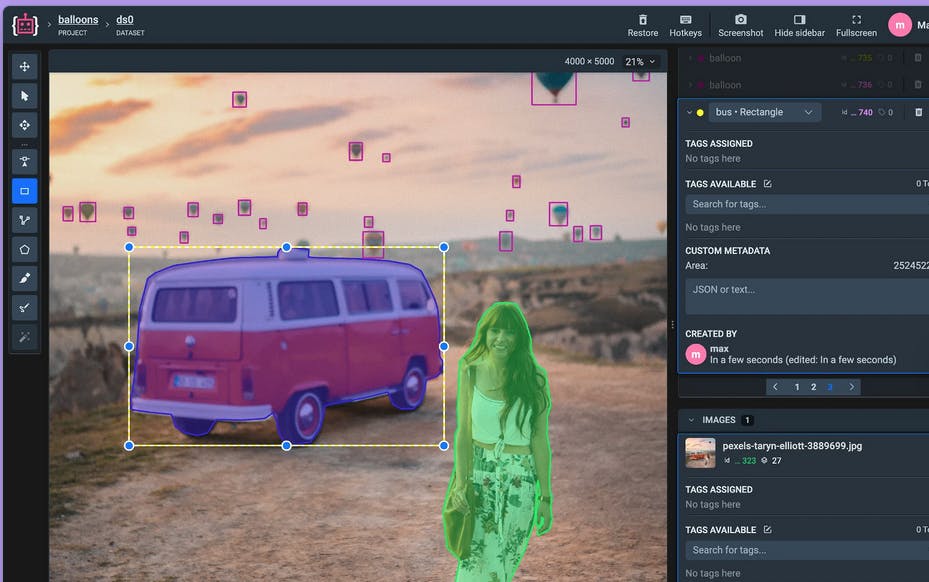
Supervisely
Benefits & key features:
- Native video file support, so that you don't need to cut them into segments or images
- Automated multi-track timelines within videos
- Built-in object tracking and segments tagging tools, and numerous other features for video annotation, QA, collaborative working, and computer vision model development
Best for:
ML, data ops, and AI teams in Fortune 500 companies and computer vision research teams.
Modalities Covered:
- Image
- Video
- Point-Cloud
- DICOM
Pros:
- Interface is intuitive and highly visual
- Offers specialized tools for advanced annotation types, such as semantic segmentation
- Incorporates AI-assisted labeling tools
- Users can create custom plugins and scripts
Cons:
- Does not provide a built-in labeling workforce
- Lacks some advanced workflow automation features
Pricing:
30-day free trial, with custom plans after signing-up for a demo.
Scale
Scale is positioned as the AI data labeling and project/workflow management platform for “generative AI companies, US government agencies, enterprise organizations, and startups.”
Building the best AI, ML, and CV models means accessing the “best data,” and for that reason, it comes with tools and solutions such as the Scale Data Engine and Generative AI Platform.
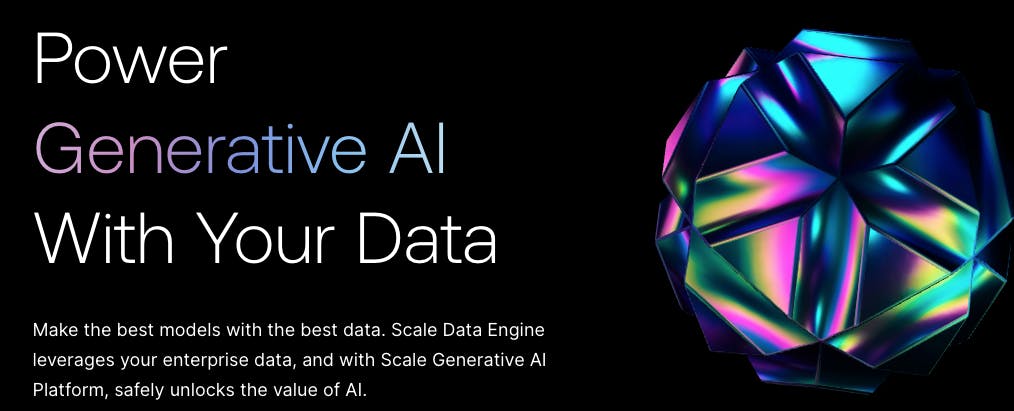
Scale, an enterprise-grade data engine and generative AI platform
Benefits & key features:
- A Data Engine to unlock data organizations already have or can tap into vast public and open-source datasets
- Tools to create synthetic data (e.g., generative AI features)
- A full-stack Generative AI platform for AI companies and US government agencies
- An extensive developers platform for Large Language Model (LLM) applications.
Best for:
Data scientists and ML engineers in generative AI companies, US government agencies, enterprise organizations, and startups.
Modalities Covered:
- Image
- Video
- Test
- Documents
- Audio
Pros:
- High-quality annotations with human-in-the-loop labeling
- Optimized for speed, providing fast delivery times even on large datasets
- Supports a range of complex data types, including 3D point clouds and LiDAR data
- Built-in quality control measures
Cons:
- May not offer the depth of customization needed for highly specific or unconventional labeling tasks
- Not as deeply integrated with automated labeling as some competitors
- Does not integrate directly into machine learning pipelines
Pricing:
There are two core offerings: Label My Data (priced per-label), and an Enterprise plan that requires a demo to secure a price.
Best Free Video Annotation Tools
LabelMe
LabelMe is an open-source online annotation tool developed by the MIT Computer Science and Artificial Intelligence Laboratory. It includes the downloadable source code, a toolbox, an open-source version for 3D images, and image datasets you can train computer vision models on.

LabelMe
Benefits & key features:
- LabelMe includes a dataset you can use to train models on, and you can use the LabelMe Matlab toolbox to annotate and label them (here’s the Github repository for this)
- It also comes with a 3D database with thousands of images of everyday scenes and object categories
- You can also outsource annotation using Amazon Mechanical Turk, and LabelMe encourages this here.
Best for:
ML and annotation teams. Although, given the open-source nature of LabelM and the database, it may be more effective and useful for academic rather than commercial computer vision projects.
Modalities Covered:
- Image
- Video
Pros:
- Free to use and offers flexibility for teams and researchers with limited budgets
- Can be self-hosted, giving users complete control over data privacy and security
- Developers can modify to add features or customize its functionality
Cons:
- Lacks AI-assisted labeling features like auto-segmentation or object tracking
- Lacks quality control and collaboration features
- Requires manual data uploading and exporting
Pricing:
Free, open-source.
CVAT
CVAT (Computer Vision Annotation Tool) started life as an Intel application that they made open-source, thanks to an MIT license. Now it operates as an independent company and foundation, with Intel’s continued support under the OpenCV umbrella.
CVAT.org has moved to its new home, at CVAT.ai.
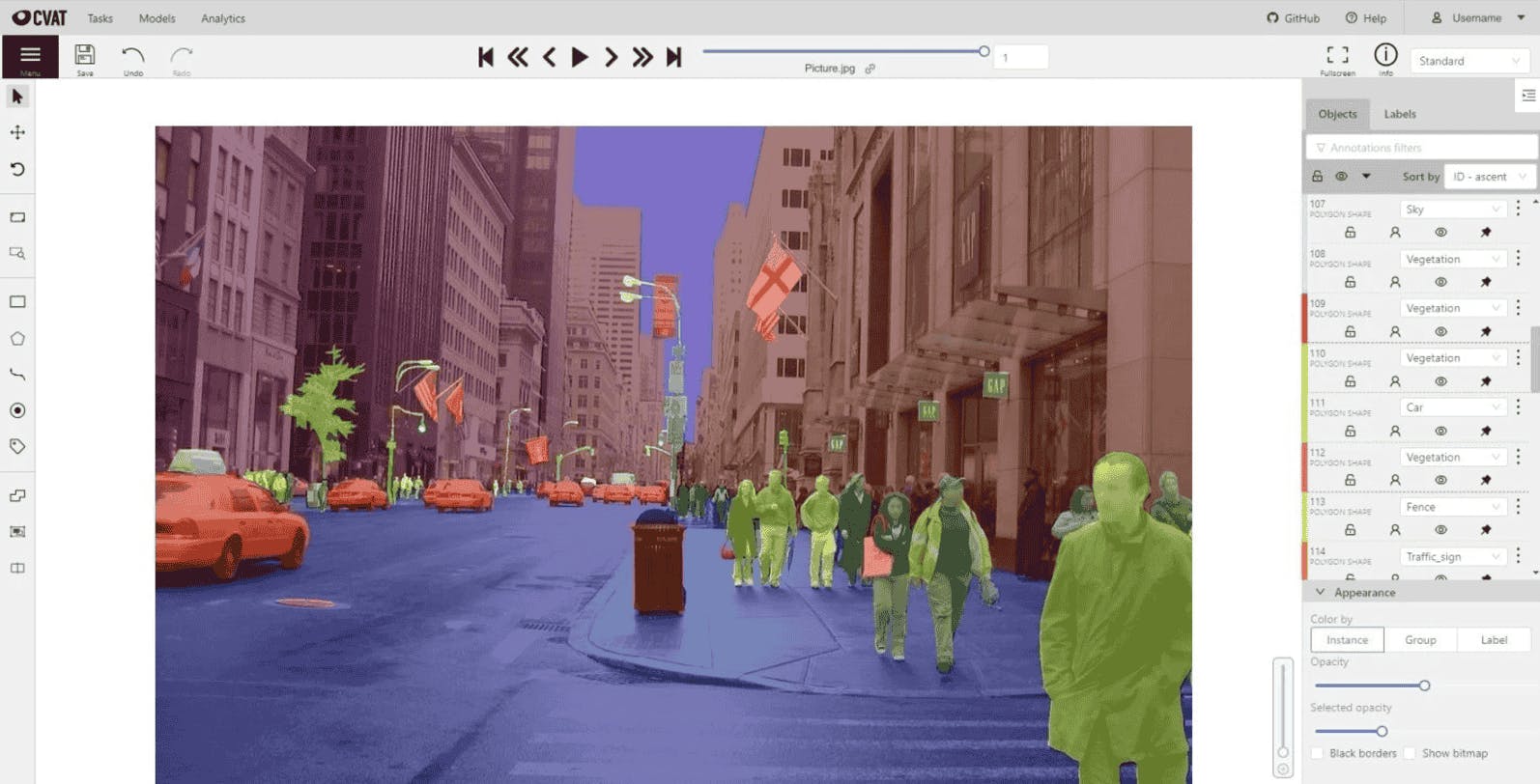
CVAT
Benefits & key features:
- CVAT is now part of an extensive OpenCV ecosystem that includes a feauture-rich open-source annotation tool
- With CVAT, you can annotate images and videos by creating classifications, segmentations, 3D cuboids, and skeleton templates
- Over 1 million people have downloaded it since CVAT launched, and under OpenCV, there’s an even larger community of users to ask for guidance and support.
Best for:
Data ops and annotation teams that need access to an open-source tool and ecosystem of ML engineers and annotators.
Modalities Covered:
- Image
- Video
Pros:
- Free to use and highly customizable
- Specialized support for video annotations with features like frame-by-frame annotation and object tracking
- Includes quality control features
- Integrates with machine learning models to provide semi-automated labeling
Cons:
- Running CVAT, especially for video annotations or large datasets, can consume considerable CPU and memory resources
- While it offers basic task assignment and review workflows, it lacks sophisticated project management features
- Doesn’t offer native integration with popular cloud storage services
Pricing:
Free, open-source.
Img Lab
Img Lab is an open-source image annotation tool to “simplify image labeling/ annotation process with multiple supported formats.” Img Lab is an excellent starting point for individuals or small teams needing a lightweight and free solution for video or image annotation. However, its limited features and scalability make it better suited for smaller or less demanding projects, especially when compared to more robust enterprise-grade tools.

Img Lab
Benefits & key features:
- Lightweight and straightforward design for quick adoption and ease of use.
- Supports a variety of data formats to accommodate different project requirements.
- Minimal installation and configuration requirements.
- Backed by an open-source community that can provide assistance and continuous improvements.
Best for:
Img Lab seems best equipped for annotators and those who need a quick and easy-to-use open-source annotation tool.
Modalities covered:
- Image
- Video (not native)
Pros:
- Cost-Effective: Free to use, making it accessible for small-scale or academic projects.
- Flexibility: Open-source nature allows for customization to suit specific workflows or requirements.
- Ease of Use: Simple and intuitive interface that doesn't overwhelm new users.
- No Dependencies on External Services: Fully offline and self-contained, enhancing security for sensitive data.
Cons:
- Limited Features: Lacks advanced functionalities like AI-powered automation, object tracking, or built-in QA workflows.
- Scalability Issues: Not suitable for large-scale or complex projects without integration with other tools.
- Manual Processes: Annotation is predominantly manual, which can be time-consuming for large datasets.
- No Built-In Collaboration Tools: Doesn't support team-based workflows or annotator management out of the box.
- Basic User Support: Relies on community forums for troubleshooting, which might not be sufficient for all users.
How To Pick the Best Video Annotation Tool for Computer Vision Projects?
And there we go, the best video annotation tools for computer vision!
In this post, we covered Encord, LabelMe, CVAT, SuperAnnotate, Dataloop, Supervisely, Scale, and Img Lab.
Each tool and suite of features that are included are applicable to a wide-range of use cases, data types, and project scales.
Making the right choice depends on what your computer vision project needs, such as supporting various data modalities and annotation types, active learning strategies, and pricing.
When you’ve selected the best annotation tool for your project or AI application will accelerate model development, enhance the quality of your training data, and optimize your data labeling and annotation process.
Best Video Annotation Tools: Key Takeaways
- The top tools—like Encord, LabelMe, CVAT, SuperAnnotate, Dataloop, Supervisely, Scale, and Img Lab—cater to a wide variety of use cases, ranging from academic research to enterprise-grade AI workflows.
- Many tools, such as Encord and Dataloop, offer AI-powered features like automated object tracking and active learning, significantly speeding up annotation processes and improving data quality.
- Options range from free, open-source platforms like CVAT and LabelMe to comprehensive enterprise solutions like Supervisely and Scale, which include robust support and advanced features for managing complex projects.
- Platforms like SuperAnnotate and Encord provide end-to-end solutions for managing annotators, workflows, and quality assurance, making them ideal for teams working at scale.
Ultimately, the right tool will help you streamline your annotation process, improve the quality of your training data, and accelerate the development of computer vision models.

Explore the platform
Data infrastructure for multimodal AI
Explore product
Explore our products
- Encord's collaborative video annotation platform helps you label video training data more quickly, build active learning pipelines, create better-quality datasets and accelerate the development of your computer vision models.
- Automate video annotations without frame rate errors with AI-assisted labeling. Create high quality training data & build production-ready models faster without compromising on accuracy with Encord's leading collaborative tool for video annotation.
- Encord's video annotation tool allows you to efficiently label any computer vision modality across image, video, DICOM, or geospatial data and choose from a variety of tools to meet your annotation needs: object detection, keypoint skelton pose, hanging protocols, action recognition, frame classifications, polygons, polyline annotation.


